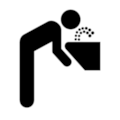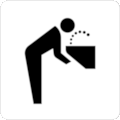Facts and data on pictograms

Synonyms / Other Terms Used
Water Fountain
Category
Public Facilities
Message / Function
To signify a drinking fountain
Note: Drinking Water from the tap is not included
| Source | Description | |
|---|---|---|
 |
AIGA | Side view of human figure bent over drinking fountain, arm below, water shown as two parallel dotted lines |
 |
CNIS | Side view of human figure bent over drinking fountain, arm below, water shown as two parallel dotted lines |
 |
Eco-Mo Foundation |
Side view of human figure bent over drinking fountain, arm below, water shown as dotted line |
 |
EJP | Side view of human figure bent towards drinking fountain, water shown as dotted line |
 |
WSCS | Side view of human figure bent towards drinking fountain, all in outline, water shown as dotted line |
 |
GTAAC | Side view of human figure bent towards drinking fountain, water shown as arc and two drops |
 |
WAY2GO | Side view of human figure bent towards drinking fountain, all reduced to lines |
 |
O'64 | Side view of head in profile above drinking fountain, water shown as dotted line |
 |
Picto'grafics | Side view of head in profile above drinking fountain, water shown as dotted line |
 |
Koszkalda | Side view of drinking fountain, water shown as two parallel dotted lines |
Note: Some of the examples shown above were mirrored horizontally to contrast differences.
Discussion
Of the few pictogram variants we have in our collection, only two were examined on basis of a test:
In a Japanese study to propose domestically unified graphical symbols based on scientific methods, the pictogram variant labeled as Eco-Mo Foundation proved to be well comprehensible with a comprehension score of 91.9 (Eco-Mo Foundation, 2001), but the visibility score found is one of the lowest among the pictograms examined.
Fiori (2008) examined a map symbol similar to the pictograms at the top of the table above, but as small scale reproduction where the water drops were not visible anymore, and correct responses were much lower than the results mentioned before with 38.1 %. About one third (36.2 %) did not respond and wrong responses included for example answers like Sink/Washbasin, Cleaning, Trash.
The AIGA pictogram shown at the top of the table above was one of the symbols examined in a study of way-finding symbols for healthcare facilities conducted in the United Arab Emirates. With 90 % of the answers classified as correct it was well understood in a Comprehension Test carried out with a sample consisting mostly of young and well educated respondents (Hashim et al., 2014).
The data reported above indicates that a new design is necessary so persons affected by visual impairments can profit from inclusive information, but also for small scale reproduction as used for example in maps.
Recommendations


Based on test results available we recommend the use of a pictogram similar to the ones provided by AIGA or the Eco-Mo Foundation as they seem to be sufficiently comprehensible.
We further suggest to conduct a Comprehension Test comparing these concepts with new designs with larger minimum details and better visibility necessary for persons affected by visual impairments, to correct this recommendation. For these redesigns it should be taken care to avoid confusions with Washroom, Cleaning noticed in the Brazilian research and also in our own observations.
Tests of pictograms of referent Drinking Fountain
Eco-Mo Foundation (2001): Test data of public information symbols in Japan - Procedure for the testing of public information symbols by the Study Committee. ISO: ISO/TC 145/SC 1 N 329.
Fiori, S. R. (2008): Mapas para o turismo e a interatividade - proposta teórica e prática. Tese de Doutorado - Depto. de Geografia, FFLCH-USP.
Hashim, M. J., Alkaabi, M. S., & Bharwani, S. (2014): Interpretation of way-finding healthcare symbols by a multicultural population: navigation signage design for global health. Applied ergonomics, 45(3), 503–509. https://doi.org/10.1016/j.apergo.2013.07.002
See also
Drinking Water
Refreshments, Vending Machine
Updated 2024-12-28 by Ch.Brugger